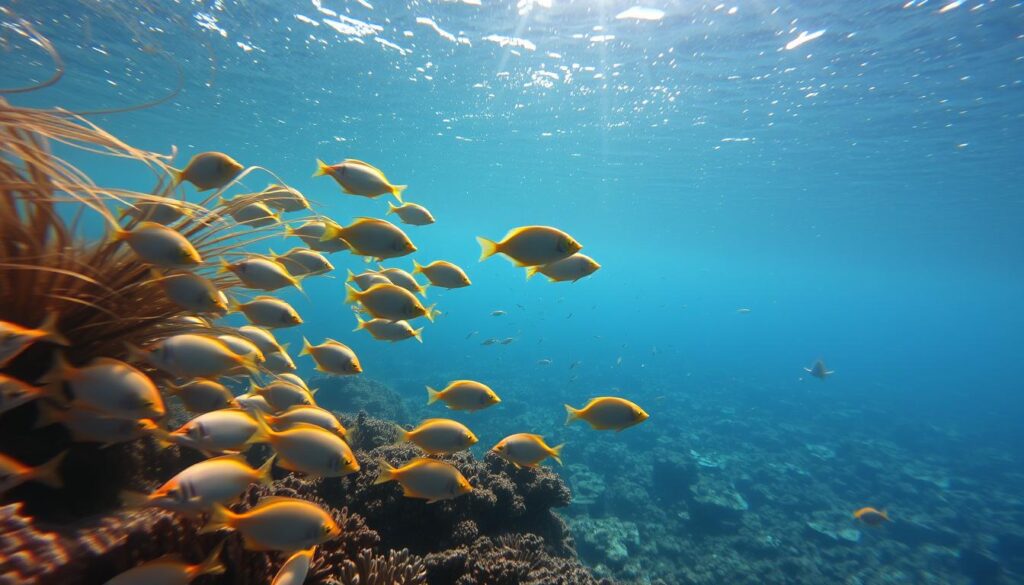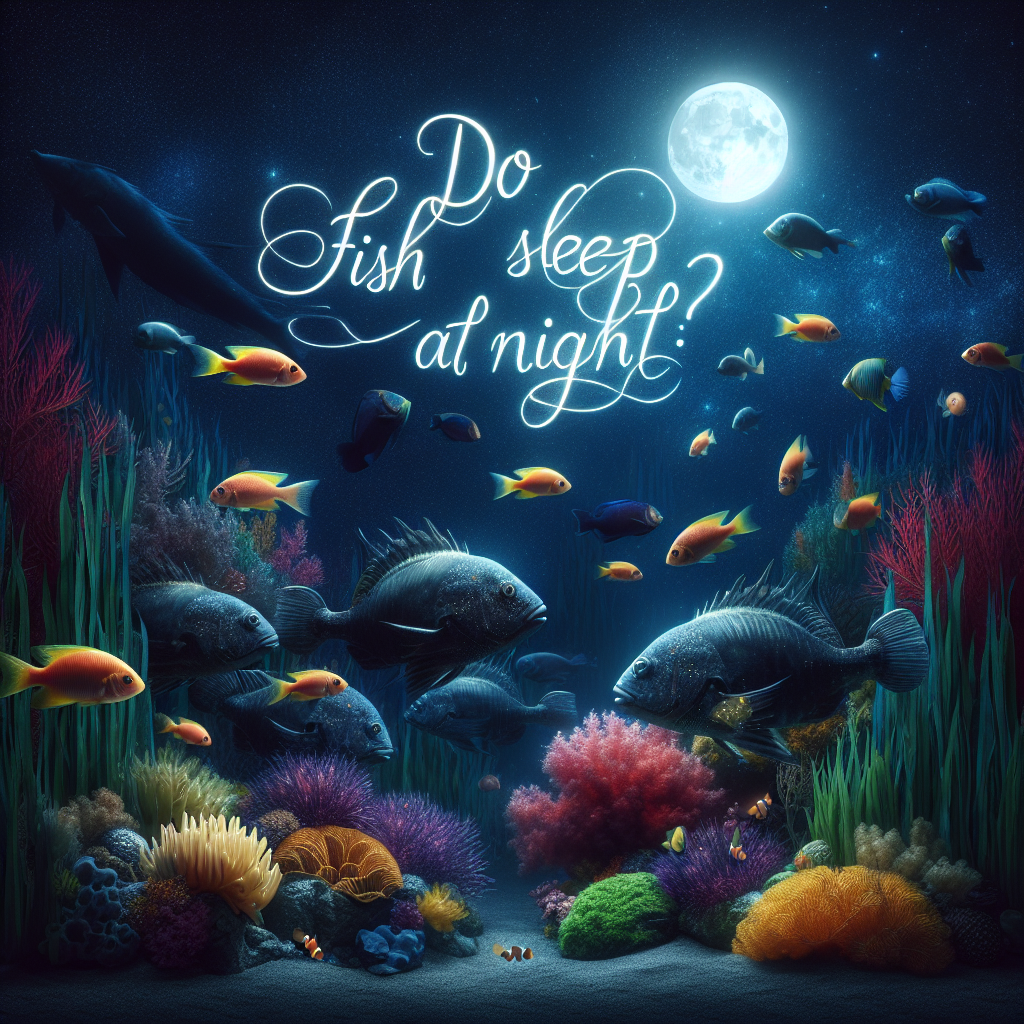Have you ever wondered if fish sleep? Yes, they do, but their sleep patterns are quite different from ours. It’s important for aquarium owners and marine biologists to understand fish sleep. This topic has become more popular in recent years, showing how complex fish behavior can be.

Exploring fish sleep reveals the need to know about their sleep patterns and behaviors. We’ll look at the various types of fish sleep and what affects their rest. Let’s dive into the world of fish sleep and uncover more about it.
Key Takeaways
- Fish do sleep, but their sleep patterns are different from humans
- Understanding fish sleep is crucial for aquarium owners and marine biologists
- Fish sleep patterns are influenced by various factors, including environment and species
- Do fish sleep patterns can vary greatly between different species
- Learning about do fish sleep can help us appreciate the complexity of their behavior
- Do fish sleep research can also inform aquarium care and management
- By studying do fish sleep, we can gain a deeper understanding of the biology and behavior of fish
The Mystery of Fish Sleep Explained
Fish sleep patterns have long been a topic of interest, with many wondering do fish sleep at night. Fish don’t have eyelids, but they still need rest to stay healthy. In the wild, they have found ways to rest while staying alert to dangers.
Studies show that fish sleep differently than humans. Some fish sleep with only half their brain at a time. This lets them stay aware of their surroundings even when resting. The question of do fish sleep at night is complex because fish sleep patterns vary greatly.
- Fish can sleep with their eyes open
- Some species of fish sleep in groups, while others sleep alone
- Fish can adjust their sleep patterns to suit their environment
Understanding fish sleep patterns helps us care for our aquatic friends better. Recognizing that do fish sleep at night is a complex question shows we value their unique needs. This way, we can provide the best care for them.
How Do Fish Sleep in Their Natural Habitat
Fish sleep patterns are truly fascinating. Understanding how fish sleep helps us appreciate their behavior. In their natural habitat, fish have unique ways to rest safely from predators. Some float just below the surface, while others settle on the seafloor or riverbed.
It’s important to note that fish sleep patterns vary by species. For example, groupers and parrotfish rest in cozy nests or crevices. On the other hand, sharks and rays swim slowly while they sleep. This shows how complex fish biology is and why we need to understand their natural habits.
Research has shown that fish have adapted to their environments in amazing ways. Some fish can sleep with only half their brain awake. This allows them to stay alert to threats. It shows the intricate relationship between fish, their sleep, and their ecosystems.
Studying fish sleep in their natural habitat helps scientists learn more about these animals. This knowledge helps us appreciate fish more and informs conservation efforts. As we delve deeper into fish sleep, we might discover even more interesting facts about them.
The Biological Need for Rest in Fish Species
Fish, like all living creatures, need rest to stay healthy. The question of do fish sleep at night is complex. Their sleep patterns are different from ours.
In the wild, fish find unique ways to rest while staying alert. Some settle on the bottom, while others hover in the water. This helps them save energy and recover from the day’s stress.
Studies show that different fish sleep in different ways. Goldfish sleep in short bursts, while sharks may rest for longer. Knowing these patterns helps us care for fish better.
Things like water temperature and quality affect fish sleep. Changes in water can upset their sleep, causing stress. A stable, comfortable environment helps fish sleep well.
Unique Sleeping Positions of Various Fish Species
Exploring how fish sleep reveals their diverse sleeping positions. Fish have unique adaptations to their environments, shown in their sleep patterns. Some float just below the surface, while others rest on the bottom.
Studying these sleep behaviors offers a peek into the complex world of fish sleep. For example, some fish sleep near the water’s surface, while others rest on the bottom. This difference is due to factors like avoiding predators, water currents, and finding food.
Looking at different fish species, we see two main sleep types: floating and anchoring. Floating sleepers, like sharks and rays, rest suspended in the water. They use a buoyant liver or other adaptations to stay afloat. Anchoring sleepers, however, rest on surfaces like rocks or vegetation. This variety shows the complexity of fish sleep and their environmental adaptations.
Surface Sleepers vs Bottom Dwellers
- Surface sleepers: rest near the surface of the water
- Bottom dwellers: sleep on or near the substrate
Floating vs Anchoring Sleep Behaviors
These unique sleep positions and behaviors highlight the fascinating world of fish sleep. Understanding how fish sleep offers insights into their biology and ecology.
Do Fish Sleep at Night? Understanding Their Sleep Schedule
Fish, like all living creatures, need rest to survive. But do fish sleep at night like humans do? The answer is not a simple yes or no. Fish have a unique way of sleeping that is different from mammals and birds. While they do not have eyelids, they can still rest and conserve energy.
In their natural habitat, fish have developed various ways to sleep. Some fish, like groupers and parrotfish, will settle on the bottom of the ocean floor, while others, like tuna and mackerel, will continue to swim slowly while they rest. This behavior is often referred to as « stationary rest » or « slow swimming ».
Research has shown that fish have a circadian rhythm, which is regulated by an internal clock that responds to light and darkness. This means that fish are more likely to be active during the day and rest at night. However, their sleep patterns can vary depending on the species, water temperature, and other environmental factors.
Here are some interesting facts about fish sleep: * Fish can sleep with only half their brain at a time, keeping the other half alert for predators. * Some fish, like sharks, can sleep while still swimming. * Fish do not have a traditional sleep-wake cycle like humans do, but they still need rest to survive.
Fascinating Sleep Adaptations in Different Fish
Fish have special ways to sleep to survive in their homes. Many wonder, do fish sleep at night? We can’t ask them, but it seems they do rest. Deep sea fish, for instance, sleep while staying ready for danger.
In coral reefs, fish sleep together, watching out for predators one at a time. This keeps them safe while they rest. Freshwater fish sleep alone, hiding in plants or under rocks to stay hidden from predators.
- Deep sea fish can sleep with their eyes open, allowing them to detect potential threats even while resting.
- Coral reef fish have developed a unique way of sleeping in groups, taking turns to keep watch for predators.
- Freshwater fish tend to sleep alone, often hiding in plants or under rocks to avoid predators.
These sleep patterns show how different fish have adapted to their environments. Learning about these adaptations helps us understand fish better. It shows how sleep is key to their daily lives.
Common Misconceptions About Fish Sleep
Many people wonder how do fish sleep. There are a few myths that need clearing up. One myth is that fish never sleep, always staying alert. But, studies show fish do rest and sleep, even if it’s not like humans.
Another myth is that all fish sleep the same way. But, different fish have their own sleep patterns. Some sleep in short bursts, while others rest for longer. Knowing these differences helps us understand fish sleep better.
Some common myths about fish sleep include: * Fish do not have a circadian rhythm * Fish are always awake and alert * All fish sleep in the same way These myths can be debunked by learning about different fish sleep patterns. By understanding how do fish sleep, we can appreciate the fascinating world of fish more.
How to Tell if Your Pet Fish is Sleeping
As a pet fish owner, you might wonder if your fish get enough sleep. Do fish sleep is a common question. Yes, they do, but their sleep patterns are different from ours.
To see if your fish is sleeping, look for signs like hovering near the tank bottom or hiding in plants.
Some fish, like betta fish and goldfish, are active during the day and sleep at night. Others, like neon tetras, are active at night and sleep during the day. Knowing your fish’s sleep patterns helps you create a comfy resting place for them.
Signs of Rest in Aquarium Fish
- Reduced activity: If your fish are normally active but now hover or rest, they might be sleeping.
- Changes in color: Some fish may change color or become less vibrant when resting.
- Hiding: If your fish hide in plants or behind decorations, they might be trying to rest.
Creating Optimal Sleep Conditions
To help your fish get a good rest, keep their tank quiet and dark at night. Adding plants or decorations can provide hiding spots for them to rest. By understanding and meeting your fish’s sleep needs, you can help them stay healthy and happy.
Conclusion: The Complex Reality of Fish Sleep
The sleep patterns of fish are much more complex than we might think. Different species sleep in unique ways, and deep-sea fish have special adaptations to rest. These facts show that fish sleep is not just about floating still.
Some fish sleep at night, while others find creative ways to rest. It’s clear that sleep is crucial for fish. By learning about fish sleep, we gain a deeper appreciation for their lives. The study of fish sleep will continue to reveal more fascinating facts.
FAQ
Do fish sleep?
Yes, fish do sleep, but their sleep is different from mammals and birds. They have various sleep-like states that help them survive and stay healthy.
How do fish sleep in their natural habitat?
Fish sleep in many ways, based on their type and where they live. Some rest near the surface, while others sleep on the seafloor. Coral reef fish might float or anchor themselves while sleeping.
Do fish sleep at night?
Fish sleep patterns vary, and not all sleep at night. Some are active during the day and rest at night. Others are active at night and sleep in the day. Their sleep schedule depends on their environment and food availability.
What constitutes sleep in fish?
Fish sleep is marked by less activity and a unique brain activity pattern. They don’t have the same sleep stages as humans. Yet, they do have rest periods that help them recover.
What are the biological needs for rest in fish species?
Fish need rest and sleep to conserve energy, repair tissues, and remember things. Each fish species has its own sleep cycle and pattern, suited to its environment and behavior.
What are some unique sleeping positions of various fish species?
Fish sleep in many unique ways. Some rest near the surface, while others anchor to the seafloor. Coral reef fish float, and freshwater fish might sleep in caves.
What are some common misconceptions about fish sleep?
Many think fish never sleep, but they do. Another myth is that all fish sleep the same way. In reality, their sleep patterns vary greatly.
How can you tell if your pet fish is sleeping?
Signs of a sleeping fish include less swimming, less response to things around them, and a specific sleep posture. Good sleep conditions, like low light and quiet, help your fish rest well.




